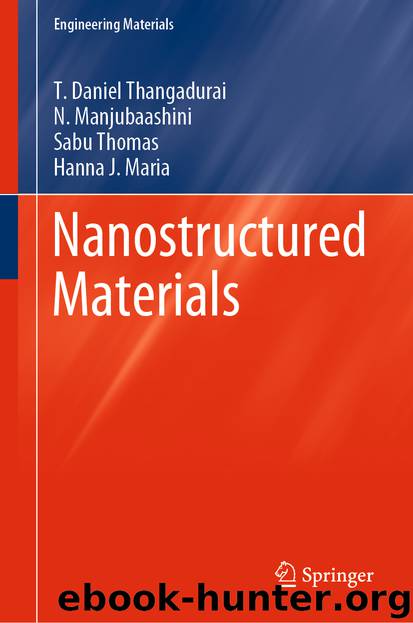Nanostructured Materials by T. Daniel Thangadurai & N. Manjubaashini & Sabu Thomas & Hanna J. Maria

Author:T. Daniel Thangadurai & N. Manjubaashini & Sabu Thomas & Hanna J. Maria
Language: eng
Format: epub
ISBN: 9783030261450
Publisher: Springer International Publishing
8.4 Solution-Based Chemistry
In addition to the vapor phase growth techniques discussed so far, several solution phase deposition techniques have been used for the growth of various alternative nanostructures.
8.4.1 Hydrothermal Synthesis
Tungsten oxide nanowires (WO2.72) were grown by hydrothermal technique and were tested for hydrocarbon sensing. Sensors based on WO2.72 nanowires show high sensitivity for 50–2000 ppm of LPG (propane–butane mixture) at 200 °C as well as relatively short recovery and response times. These WO2.72 nanowires were prepared by solvothermal synthesis. Tungsten hexachloride (1 g) was loaded into a 25 ml autoclave filled with ethanol up to 90% of its volume. Hydrothermal synthesis was carried out at 200 °C for 24 h. The product obtained by centrifugation was washed with ethanol. The as-grown nanowires were having diameters of 5–15 nm and lengths of 100–200 nm. ZnO nanorods can also be grown by hydrothermal techniques. Zinc and cetyltrimethylammonium bromide (CTAB) were used as the precursors. CTAB (1.5 g) was dissolved in deionized water (35 ml) to form a transparent solution. Then, zinc powders (1.8 g) were added to the above solution under continuous stirring. The resulting suspension was transferred into a teflonlined stainless steel autoclave (volume 40 ml) and sealed tightly. Hydrothermal treatments were carried out at 182 °C for 24 h. The autoclave was then cooled down. Next precipitates were collected, washed with deionized water for several times, and dried in air. The lengths of the ZnO nanorods are usually shorter than 1 mm and their diameters ranging from 40 to 80 nm. These nanorods were used for the sensing of various vapors including alcohol, LPG, gasoline, ammonia, etc. Vanadium oxide (V2O5) nanobelts coated with Fe2O3, TiO2, and SnO2 nanoparticles have been prepared by mild hydrothermal reaction. For the growth of the V2O5 nanobelts, nitric acid was added dropwise to a 0.1 M ammonium metavanadate solution until the final pH value of the solution reached about 2–3 under stirring. Solution obtained was transferred to a Teflon-lined autoclave and filled with deionized water up to 80% of the total volume. Then the autoclave was kept at 180 °C for 24 h. The final product was washed with deionized water and pure alcohol several times to remove any possible remnants. The as-grown nanobelts were tens of micrometers long with smooth surfaces, typically 60–100 nm wide and 10–20 nm thick. These nanobelts were then coated with the oxide nanoparticles for the sensing of alcohol, benzene, cyclohexane, gasoline, ammonia, etc. NiFe2O4 nanospheres, nanocubes, and nanorods were prepared by a hydrothermal method. For synthesizing these NiFe2O4 nanostructures, Ni(NO3)2·6H2O and Fe(NO3)3·9H2O were dissolved in deionized water to form a mixed solution with [Na2+] = 0.10 mol/l and [Fe3+] = 0.20 mol/l. NaOH solution (6.0 mol/l) was added dropwise under stirring into 20.0 ml of the mixed solution until the desired pH value was attained to form an admixture. In the next step, the admixture was transferred to a Teflon autoclave (50 ml volume) with a stainless steel shell up to 80% of the total volume. The autoclave was kept at 120–200 °C for 24–96 h and then cooled down.
Download
This site does not store any files on its server. We only index and link to content provided by other sites. Please contact the content providers to delete copyright contents if any and email us, we'll remove relevant links or contents immediately.
| Automotive | Engineering |
| Transportation |
Whiskies Galore by Ian Buxton(41525)
Introduction to Aircraft Design (Cambridge Aerospace Series) by John P. Fielding(32885)
Small Unmanned Fixed-wing Aircraft Design by Andrew J. Keane Andras Sobester James P. Scanlan & András Sóbester & James P. Scanlan(32569)
Craft Beer for the Homebrewer by Michael Agnew(17928)
Turbulence by E. J. Noyes(7694)
The Complete Stick Figure Physics Tutorials by Allen Sarah(7135)
Kaplan MCAT General Chemistry Review by Kaplan(6591)
The Thirst by Nesbo Jo(6432)
Bad Blood by John Carreyrou(6271)
Modelling of Convective Heat and Mass Transfer in Rotating Flows by Igor V. Shevchuk(6219)
Learning SQL by Alan Beaulieu(6029)
Weapons of Math Destruction by Cathy O'Neil(5824)
Man-made Catastrophes and Risk Information Concealment by Dmitry Chernov & Didier Sornette(5643)
Digital Minimalism by Cal Newport;(5388)
Life 3.0: Being Human in the Age of Artificial Intelligence by Tegmark Max(5182)
iGen by Jean M. Twenge(5158)
Secrets of Antigravity Propulsion: Tesla, UFOs, and Classified Aerospace Technology by Ph.D. Paul A. Laviolette(4980)
Design of Trajectory Optimization Approach for Space Maneuver Vehicle Skip Entry Problems by Runqi Chai & Al Savvaris & Antonios Tsourdos & Senchun Chai(4837)
Electronic Devices & Circuits by Jacob Millman & Christos C. Halkias(4741)
